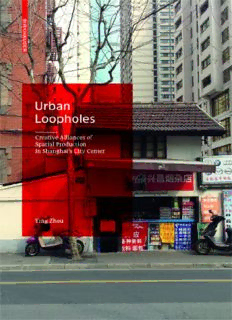Table Of ContentUrbanLoopholes
YingZhou
Urban Loopholes
CreativeAlliancesofSpatialProductioninShanghai’sCityCenter
Birkhäuser
Basel
6
Preface
14
UrbanTransformationinDiverseInner-cityNeighborhoodsinShanghai
ForewordbyKeesChristiaanse
17
Chapter1:Introduction
22 TheContextoftheTransitionEconomyandtheChineseCity
30 ConceptualFramework:theUrbanLoophole
37 ResearchMethods
48 ExistingStudiesonUrbanChinainTransition
54 ContentandStructure
69
Chapter2:TheResidentialNeighborhood
80 SeedsofHousingMarketization,ForeignInvestment,and
ReconnectingtotheWorld
86 StateInstitutions,HousingMarketization,andtheGapof
Opportunity
90 ExpeditedKnow-HowImportandtheDualMarket
99 BeforetheTower:theLilong
106 OriginsoftheResidualConditions
111 PreservationofAmbiguousPropertyRights
118 DemographicShiftandCommercialSpatialDemand
126 IncrementalConversionsandSmallCreativeEntrepreneurs
129 ChangingHabitat
143
Chapter3:TheCulturalStreet
150 FromFirstRecognitionsofArchitecturalHeritageto
Implementation
162 SettingtheContextforHeritagePolicyImplementation
170 TheOldHouseandtheClubHouse—ChangingMarketSupply
andDemand
177 LocalizedCosmopolitansandtheDevelopingofLePassage
FuxingandFergusonLane
185 ConservingHeritage:Lane1754(Aka1768)andLane117
198 The‘Western’DistrictandLearningfromthe‘BeautificationPlan’
206 TheWorldPrimarySchoolandSmallEntrepreneurs
210 ApproximatingGlobalizationandtheState’sAppropriation
235
Chapter4:TheMidtownofChina
243 TheParagonofEconomicLiberalization:Jing’anDistrictandtheDevelopment
ofWestNanjingLu
254 EvocationofHeritage—RedefiningJing’anVillas
261 Jing’anVillas’CommercializationandCreativeEnterprises
272 ThePrecedentofTianzifangforCommercialization
281 ThePublicRelationsWarsandtheDifferingVisionsofJing’anVillas’Future
287 TheNeighboringEn-BlocDevelopmentofDazhongli
296 ZhangGardens:Jing’anDevelopsItsHeritageValue
313 GentrificationwithChineseCharacteristics
335
Chapter5:TheNewEconomies
339 AlternativeBusinessPlanforCreativeIncubation:AnkenGreen
350 NewLocal-GlobalAlliances:theUpgradeofYongkangLu
364 TheNewEconomies
379
Chapter6:TheContemporaryArtEcologies
384 FromContestationtoAppropriation:theTransformationofM50
394 “MadeinChina”:NewMuseumsandtheBusinessofArt
400 UncertaintyandRegeneration
404 ArtandArchitectureCatalyzeDevelopment
408 ContemporaryArtEcologies
423
Chapter7:Outlook
425 CasesfromShanghaiandUrbanLoopholes
428 ShiftsintheUrbanLoopholesunderEconomicTransition
430 TheUrbanLoopholesasEquilibratorsandLearningFromtheUrbanLoophole
435
Acknowledgments
437
AbouttheAuthor
438
IllustrationCredits
441
IndexofPersons,Institutions,andFirms
Preface
“Ifwedon’tknowwherewecomefrom,wearestandingnowhere.”
AiWeiwei,interviewwithEvanOsnosfortheNewYorkerFestival,2014
When I want to describe what it was like to live under the strictures of a socialist
plannedeconomy,Iusuallystartwithafondmemoryoficecreamintheearly1980s.
IntheswelteringsummersofShanghaibackthen,Iwouldexplain,thereweretwo
kindsoficecreamtowhichachildlikemyselfcouldlookforward.Bothwerecubic
blocks wrapped in thin wax paper packed in blue cardboard boxes, and opened to
thecreamywhite‘icedbricks[冰砖]’withtheonlyflavorpossibletoicecreamachild
ofthatplaceandthattimecouldknow.Thechoicebetweenthe‘medium-sizedbrick
[中砖]’andthe‘large-sizedbrick[大砖]’wasanobviousone,althoughIhadtoweigh
themeltingspeedofthelargerpieceagainsttheinfrequencyofrefrigeratorsinthecity.
Icecreamissomethingtowhichalmosteveryonereadingthiscanrelate.Iuseice
creamtoexplainbecausetheabundancerepresentedbythecontemporarydiversity
offlavors,sizes,types,nottomentionplaceswhereonecouldprocurethem,issome-
thingthatweoftentakeforgranted.Mylimitedscopeoficecreamcorrespondedwith
adrawn-outerainChinesehistorywhencentralplanninghadalsocontrolledevery
aspectofdailylife,fromconsumerproductsandhousingtoeducationandjobs.Itiso-
latedthevastcountryofbillionsfromthechangingoutsideworld.Centralplanning
andthepoliticalideologiesofsocialismareabstractconcepts.Buttheavailabilityand
choiceoficecreamisaconcrete,livedexperience.Fromourperspectiveoflivingin
globallyconnectedmarketeconomies,wherehavingchoicesisagiven,afundamental
reflectiononthetremendoustransformationsthathavetakenplaceinChina,bring-
ingitfromoneofsocialistplanningtomarketcapitalism,ormoreconcretelyfrompre-
ciouslylimitedtooverwhelmingchoicesforicecream,iscrucialtoanyfurtherstudies
ofthecountry,andothersimilarlymanagedplacesintheworldtoday.
Iuseicecreamtoexplain,also,because,asanarchitect,Iamalsointerestedinthe
placewhereIhadlinedupattheDairyFactory[牛奶棚].Today,itiswherethewhite
tiledmammothoftheShanghaiLibrarystands.LikemanypartsofthecityofShanghai
thathaveundergonecompleterenewalsincetheearly1990s,theneighborhood—my
memoriesoficecreamqueuestookplacehere—whichhadbeenasuburbanedgeof
the1980scity,hasalsobecomecentrallylocatedprimerealestateintheexpansive
metropolisofShanghaitoday.Intheproliferationofconsumerchoicesandthespatial
expansionwithinthethreedecadessinceeconomicliberalizationbegan,thetransfor-
mationsofShanghaihavebeentremendous.Thetransformationsinthemunicipalre-
gionofmorethantwenty-plusmillionareembodiedinmymemoryofthoseicecream
blocks.Fromthehumbleandlocallyproducedblue-packagedGuangmingbrand,the
onlyoneatthetime,totoday’ssnazzyHäagen-Dazsparlors,fro-yobars,icedmoon-
cakefads,andwhatnot,notonlyhasconsumerism,propelledbyglobally-circulated
capitalism,returnedandblossomed;buttogetherwithpoliciesanddevelopmentsthat
havemadeitallpossible,ithasresultedinlocallyspecificurbanspatialproductions
thathavefundamentallyreshapedthecity.Boththechangingurbansocietyandits
spatialtransformationsareimportanttotheensuingstudy.(Fig.1)Throughlensesspe-
6
Fig.1PhotocollageofDengXiaopingfromalargemuralfeaturingtheskylineofShenzhenandrepresenting
China’seconomicliberalizationaspropelledbytheDeng-ledcentralgovernment,withtheskylineofShanghai’s
BundandPudong,representingthecentralgovernment’sdecisiontomakeShanghaithe‘Dragon’sHead’of
thenation,initiatingacceleratedeconomicmarketizationandtherapidurbantransitionthattookplace
(photocollagebyauthor)
cifictothedisciplineofarchitectureandurbandesign,thefollowingpiecewilltryto
unpackhowthemechanismsofurbanspatialproductionfacilitatedandmanifested
therapidgrowth,transformations,andglobalizationinthecontemporaryChinesecity
ofShanghai.Itisfromtheempiricallygatheredphysicalandsocial-economicmanifes-
tationsoftheeverydaythatthestudyofurbanspatialproductionrevealsthebroader
developmentinthepoliticaleconomyofrapidlychangingcities.
IamoftheurbangenerationborninthedecadeafterthedeathofChina’sgreat
leaderMao, and my memories span fromtheonesbeforemewho experienced the
famines of the Great Leap Forward and the turmoil of the Cultural Revolution and
thosewhocameaftermeknowingonlytherapidgrowthandchangeofeconomiclib-
eralization.Iwasaprivilegedchild.Ilivedinacity,andarelativelywell-offonefor
thethenimpoverishedChina.Myfamilyhadarefrigeratorinanerawhenappliances
werelimitedandboughtonlythroughforeigncurrencyexchangecertificatesprocured
fromoverseaswires.Ilivedinaflatthat,thoughcrowdedbyWesternstandards,was
notsharedwithtwoorthreeotherfamiliesandwasnotshortonmoderninfrastruc-
ture.Thewinterswerecold,forallindoorheatingapplianceshadbeenremovedby
thepost-LiberationdecreeforcitiessouthoftheYangtzeRiver.Unscientificthough
itclearlywas,theauthoritieshadperhapsreallybelievedthatcentralplanningcould ce
a
evenovercometheweatherandthatthemassiveregionsouthofYangtzedidnotneed Pref
7
heating.Nevertheless,withicecreamcamesummer,andthencamethefridge,wash-
ingmachine,television,andeventelevisionshows,ononesinglechannel.Compared
withwhenIwasborn,withmymother’shukoustillnotreturnedtoShanghaiafter
havingbeensenttothecountrysidelikemillionsofotherurbanyouths,andfoodwas
rationedandcouponsforagriculturalproductswerestillthecurrencyofexchangefor
thesocialistplannedeconomy,lifewasimproving.
Iwasfortunatetogrowupinthetimesofchange,changeforthebetternonethe-
less.WithDisney’sSnowWhiteandRomySchneider’sPrincessSissishowingatthecin-
emas,andjeansandsneakersappearinginstreetmarkets,notonlywasChinanolon-
gertormentedbypoliticalupheavalsandideologicalwarsthattooktremendoustollon
theordinarypeople’severydaylives,butcities,particularlythoselikeShanghai,were
usingtheircosmopolitanpaststoreconnecttotheoutsideworld.Inthemidstofthe
tremendouschangestocomethough,Ileftthecountry,withmyparents.Likemanyin
Shanghaiwhohadpre-1949familiallinkstotheWest,atranscontinentalchangebod-
edlife’sevenbetterbetterment.Itwasonlywhenwewatchedthehopesthathadunit-
edtheidealisticstudentsandpragmaticworkersdashed,intheTiananmenSquareof
1989,fromthesafetyinfrontofourtinybutcoloredCNN-loopingtelevision,thatmy
parents,likemanyChinesestudentswhohadonlyplannedonashortsojourninthe
U.S. beforereturning,decidedindeedtoremainawayfromtheircountry.Itwasthe
clarityofthatdefiningevent—perhapsmagnifiedbythecommentariessoopenlyut-
tered—ratherthantherepeateduncertaintiesthattheyhadsufferedinthedecades
before,thatconvincedthemofthechoice.Itwas,asIwouldonlyrealizelater,alsofor
myfuture.Iwassparedthetraumaofthe1990sstate-ownedenterprise(SOE)layoffs
andthemadoptimismofdemolitionandurbanrenewals.ButafteranEastCoastlib-
eralartseducationandstintsincitieslikeNewYork,Boston,Basel,Iwouldarrivein
Shanghai,realizingthatIhaveanunderstandingofChina’sinherentlogicandanout-
sider’seyethatsawmanythingsthatmostwhoremainedcouldnot.
ItwasearlyoneeveninginDamascus,inthefallof2009.Iwasteachingandhadin
towtwelvearchitecturestudents.Inotedoutloudthatthestreetwewerewalking
downremindedmeofShanghai.Indaylight,thepeople,thesignage,thebuildings,
surelywouldhavegivenawaythatIwasnotonHuaihaiLu,ortheformerAvenue
Joffre.Butintheearlydusklight,theproportionofspacesdupedmyabilitytodiscern
thecity.Whenwecontinuedontootherboulevardsthenextday,myvisceralconfu-
sionofplaceswasconfirmed,bytherealizationthatthosetreeswereplatanus.(Fig.2)
Theirdistanceapart,theirrelationstothesidewalk,thesetbackofthebuildingsand
theproportionsoftheroadtothearchitecture,theirroleinthebeautificationofthe
citywerepartofthespatialvocabularyforurbanismoftheFrenchmandateinDa-
mascus.TheplatanuswerealsothesameonesinShanghai.Inthewestern-endofthe
formerFrenchconcessionswhereIwasbornandgrewup,thetreeshadlovinglycan-
opiedoverthefreshlytarmackedstreetsinthesummers.Theconvergenceoftheim-
agesmademerealizetheplanningideologiesthathadshapedmineandmanyothers’
memoriesofcities.
OtherthingswelearnedinourtwoweeksinDamascusalsomademerealizethat
Icouldunderstanditsurbanism.ThiswasnotonlybecauseIunderstandalreadyits
coloniallegaciesandplanningideologies;butalsobecauseIunderstandthelogicof
8
Fig.2PhotosoftheplatanustreesfromDamascus,whichtriggeredthetheoreticalframeworkforthisstudy,2009
anothernationwithatransitioningeconomy,China,whosecityalsomanifestedits
encounterwithmodernity,Shanghai.Itwasanotherstrangelyconfirmingmoment,
whenoneofmystudents,agirlfromChongqing,burstintotearsasthedeanofDamas-
cusUniversityexplainedtheirurbantransformationprocesses.Shewasdistressedat
howsimilarlythedescriptionssoundedtotheonesweknewfromChina.Growingin-
equalitydeviatingfromtheoriginaltenetsofsocialism,therampantcommodification
ofarchitectureheritage,thedevelopmentprojectsonextra-territoriallandsbyglob-
alcapital.Theprocessesofchangethatthecountryisundergoingfollowingitseco-
nomicliberalization,andspecificallyitsurbanspatialmanifestations,echoedtheones
weknew.Theconceptofthe‘urbanloophole,’whichwillbetheunderlyingredthread
throughtheensuingtext,grewoutofmyobservationsfromDamascus,butwouldbe-
comeanimportantconceptualframeworkfordeepeningtheunderstandingofhow
theurbanspatialproductionprocessesinformedandwereimpressedbyatransition-
ingpoliticaleconomy.Thefirstinklingsoftheurbanloopholecameoutinanarticlein
theissuethemed“ResilientCities”inthejournal,CriticalPlanning,in2010.
Shanghai,thus,cameeasilyasthechosensiteforadeeperstudyusingthisna-
scentconceptualframework.Assomeonewithintimateknowledgeofthecity’spal-
ettes,memories,culture,aswellasmyundetectablylocaldialect,doorsopenedmore
readilyandmoreeasilyformethanfortransplantedscholars,evenChineseones.Ihad ce
a
gleanedenoughtounderstandthetickingofthecity.Myempathiesasaninsiderare Pref
9
Description:Ein strategisches Bundnis von stadtischer Umnutzung, Kreativwirtschaft, Konsumokonomie und Denkmalschutz hat eine bemerkenswerte Transformation innerstadtischer Quartiere in Shanghai geschaffen.In einer Verbindung von intimen Kenntnissen der lokalen Szene und kritischer Distanz entwirft die Autorin

